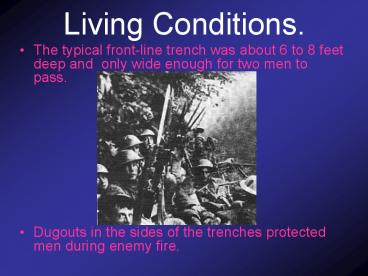Living Conditions' - PowerPoint PPT Presentation
1 / 18
Title:
Living Conditions'
Description:
Barbed wire helped protect the firing trench from surprise attacks. ... Canons. Guns. Gas Cylinders. Catapults. Grenades. Gun Powder. Bombs ... – PowerPoint PPT presentation
Number of Views:56
Avg rating:3.0/5.0
Title: Living Conditions'
1
Living Conditions.
- The typical front-line trench was about 6 to 8
feet deep and only wide enough for two men to
pass. - Dugouts in the sides of the trenches protected
men during enemy fire.
2
Living Conditions.
- Barbed wire helped protect the firing trench from
surprise attacks. Between the enemy lines lay a
stretch of ground called "no man's land. - The smell of dead bodies lingered in the air, and
rats were a constant problem. Soldiers had
trouble keeping dry, especially in areas of
Belgium.
3
Living Conditions.
- Some soldiers stood guard. Others repaired the
trenches, kept telephone lines in order, brought
food from behind the battle lines, or did other
jobs. - At night, patrols fixed the barbed wire and tried
to get information about the enemy.
4
Living Conditions Source
- What was it like to live in the trenches?
- How we do think of home and laugh at the
pettiness of our little-daily annoyances! We
could not sleep, we remember, because of the
creaking of the pantry door, or the noise of the
tramcars, or the kids playing around and making a
row. Well, we can't sleep now because - six
shells are bursting around here every minute, and
you can't get much sleep between them Guns are
belching out shells, with a most thunderous clap
each time The ground is shaking with each little
explosion I am wet, and the ground on which I
rest is wet My feet are cold in fact, I'm all
cold, with my two skimp blankets I am covered
with cold, clotted sweat, and sometimes my person
is foul I am hungry I am annoyed because of the
absurdity of war I see no chance of anything
better for tomorrow, or the day after, or the
year after.
5
Living Conditions.
- Living on the trenches was very hard, many
soldiers were executed for petty crimes. The
following table shows us the executions of
soldiers between 1914-1918
6
Life on the Trenches.
- During world war one, many soldiers caught
diseases such as - Trench Foot
- Shell shock
- Many people suffered from body lice.
- Psychological disorders
- Trench fever
- Starvation
- Nervous disorder
7
Impact Of Technology.
- In April 1915, the Germans first released poison
gas over Allied lines in the Second Battle of
Ypres. - It caused vomiting and suffocation.
- After the introduction of the poison, gas masks
were used. - Another new weapon was the flamethrower, which
shot out a stream of burning fuel.
8
Impact of technology and life in the trenches.
- We will now show a video, showing us how
harsh life was on the western front. - http//www.learningcurve.gov.uk/greatwar/g3/cs2/
g3cs2s5.htm (30seconds -1min 9) - As you can see, life on the trenches, was
certainly not fun!
9
Weapons Used.
- Canons
- Guns
- Gas Cylinders
- Catapults
- Grenades.
- Gun Powder
- Bombs
10
What was it like to experience an attack?
- The German army used chlorine gas to attack the
British army. - It was described as a yellow- green gas
- It smelled like pineapple and pepper.
- Pads covered in ammonia were used to neutralized
the chlorine. These pads were held over the face
until the soldiers could escape from the
poisonous fumes.
11
Trench System
- Whilst soldiers were sleeping, people were given
jobs to keep a look out, for the enemy attacking - They were called signallers, and they
communicated by using flags, lamps, heliographs,
Morse code and field telephones. - This was a very efficient way of working.
12
British Soldier Uniform.
The British tropical uniforms were made of pure
wool and were excellent. British troops wore
steel helmets, which were very heavy, and
uncomfortable. Heavy boots were worn Fur lined
coats were worn, which kept soldiers warm.
13
German Soldier Uniform
- As you can see this differs from the British
Uniform in many ways. - The German army uniform was made from a
watertight linen - It was cut in a certain style
- In the early mornings, the material absorbed
moisture from the dew so that it became
intolerable to wear the uniforms.
- The material was too stiff and did not give
adequate protection against hot or cold. - These uniforms proved unsuitable both in style
and material.
14
Attacking the Enemy- facts
- The Germans used poisonous gases.
- Throughout the war, the Germans used 68,000
tonnes of gas. - The British, Australian and Canadian guns, fired
4,283,550 shells at the German defences. Soldiers
sometimes developed shell shock. - The German and British Armies, both used flame
throwers, to attack their enemies.
15
War Plans.
- In 1913 General Ferdinand Foch and General
Joseph Joffre devised a strategic plan for the
invasion of Germany. It was called Plan 17. - On the outbreak of the First World War, the
French Army carried out Plan 17. After initial
success at both Lorraine and Ardennes, strong
German resistance and the success of the
Schlieffen Plan resulted in orders being given by
General Joseph Joffre on 24th August to retreat
back to France.
16
War Plans.
- Small patrols of men were occasionally sent to
no mans land to find out about the enemy army
and what they were planning.
17
Comparison between the German and British armies.
18
Thank You for Listening!































